Ahmad Rashid
Huawei Noah's Ark Lab
Towards Cost-Effective Reward Guided Text Generation
Feb 06, 2025



Abstract:Reward-guided text generation (RGTG) has emerged as a viable alternative to offline reinforcement learning from human feedback (RLHF). RGTG methods can align baseline language models to human preferences without further training like in standard RLHF methods. However, they rely on a reward model to score each candidate token generated by the language model at inference, incurring significant test-time overhead. Additionally, the reward model is usually only trained to score full sequences, which can lead to sub-optimal choices for partial sequences. In this work, we present a novel reward model architecture that is trained, using a Bradley-Terry loss, to prefer the optimal expansion of a sequence with just a \emph{single call} to the reward model at each step of the generation process. That is, a score for all possible candidate tokens is generated simultaneously, leading to efficient inference. We theoretically analyze various RGTG reward models and demonstrate that prior techniques prefer sub-optimal sequences compared to our method during inference. Empirically, our reward model leads to significantly faster inference than other RGTG methods. It requires fewer calls to the reward model and performs competitively compared to previous RGTG and offline RLHF methods.
Uncertainty-Guided Optimization on Large Language Model Search Trees
Jul 04, 2024Abstract:Beam search is a standard tree search algorithm when it comes to finding sequences of maximum likelihood, for example, in the decoding processes of large language models. However, it is myopic since it does not take the whole path from the root to a leaf into account. Moreover, it is agnostic to prior knowledge available about the process: For example, it does not consider that the objective being maximized is a likelihood and thereby has specific properties, like being bound in the unit interval. Taking a probabilistic approach, we define a prior belief over the LLMs' transition probabilities and obtain a posterior belief over the most promising paths in each iteration. These beliefs are helpful to define a non-myopic Bayesian-optimization-like acquisition function that allows for a more data-efficient exploration scheme than standard beam search. We discuss how to select the prior and demonstrate in on- and off-model experiments with recent large language models, including Llama-2-7b, that our method achieves higher efficiency than beam search: Our method achieves the same or a higher likelihood while expanding fewer nodes than beam search.
A Critical Look At Tokenwise Reward-Guided Text Generation
Jun 12, 2024



Abstract:Large language models (LLMs) can significantly be improved by aligning to human preferences -- the so-called reinforcement learning from human feedback (RLHF). However, the cost of fine-tuning an LLM is prohibitive for many users. Due to their ability to bypass LLM finetuning, tokenwise reward-guided text generation (RGTG) methods have recently been proposed. They use a reward model trained on full sequences to score partial sequences during a tokenwise decoding, in a bid to steer the generation towards sequences with high rewards. However, these methods have so far been only heuristically motivated and poorly analyzed. In this work, we show that reward models trained on full sequences are not compatible with scoring partial sequences. To alleviate this issue, we propose to explicitly train a Bradley-Terry reward model on partial sequences, and autoregressively sample from the implied tokenwise policy during decoding time. We study the property of this reward model and the implied policy. In particular, we show that this policy is proportional to the ratio of two distinct RLHF policies. We show that our simple approach outperforms previous RGTG methods and achieves similar performance as strong offline baselines but without large-scale LLM finetuning.
Preventing Arbitrarily High Confidence on Far-Away Data in Point-Estimated Discriminative Neural Networks
Nov 07, 2023
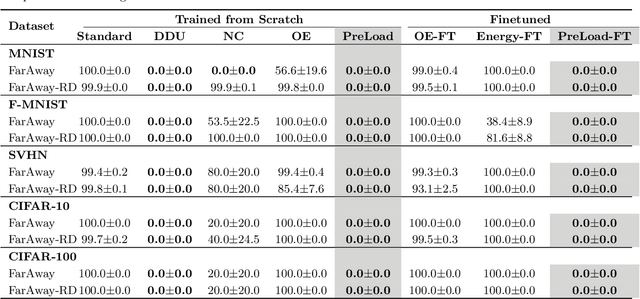


Abstract:Discriminatively trained, deterministic neural networks are the de facto choice for classification problems. However, even though they achieve state-of-the-art results on in-domain test sets, they tend to be overconfident on out-of-distribution (OOD) data. For instance, ReLU networks -- a popular class of neural network architectures -- have been shown to almost always yield high confidence predictions when the test data are far away from the training set, even when they are trained with OOD data. We overcome this problem by adding a term to the output of the neural network that corresponds to the logit of an extra class, that we design to dominate the logits of the original classes as we move away from the training data.This technique provably prevents arbitrarily high confidence on far-away test data while maintaining a simple discriminative point-estimate training. Evaluation on various benchmarks demonstrates strong performance against competitive baselines on both far-away and realistic OOD data.
Attribute Controlled Dialogue Prompting
Jul 11, 2023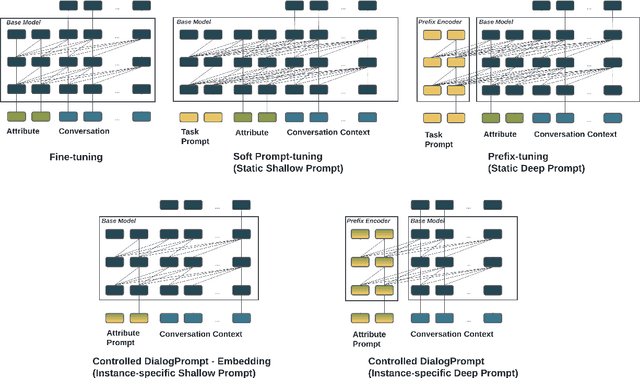


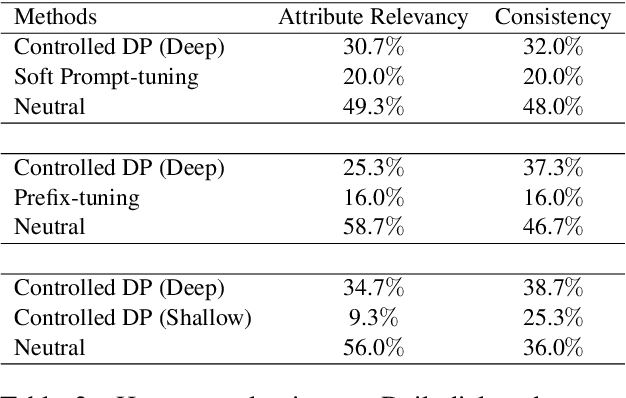
Abstract:Prompt-tuning has become an increasingly popular parameter-efficient method for adapting large pretrained language models to downstream tasks. However, both discrete prompting and continuous prompting assume fixed prompts for all data samples within a task, neglecting the fact that inputs vary greatly in some tasks such as open-domain dialogue generation. In this paper, we present a novel, instance-specific prompt-tuning algorithm for dialogue generation. Specifically, we generate prompts based on instance-level control code, rather than the conversation history, to explore their impact on controlled dialogue generation. Experiments on popular open-domain dialogue datasets, evaluated on both automated metrics and human evaluation, demonstrate that our method is superior to prompting baselines and comparable to fine-tuning with only 5%-6% of total parameters.
LABO: Towards Learning Optimal Label Regularization via Bi-level Optimization
May 08, 2023



Abstract:Regularization techniques are crucial to improving the generalization performance and training efficiency of deep neural networks. Many deep learning algorithms rely on weight decay, dropout, batch/layer normalization to converge faster and generalize. Label Smoothing (LS) is another simple, versatile and efficient regularization which can be applied to various supervised classification tasks. Conventional LS, however, regardless of the training instance assumes that each non-target class is equally likely. In this work, we present a general framework for training with label regularization, which includes conventional LS but can also model instance-specific variants. Based on this formulation, we propose an efficient way of learning LAbel regularization by devising a Bi-level Optimization (LABO) problem. We derive a deterministic and interpretable solution of the inner loop as the optimal label smoothing without the need to store the parameters or the output of a trained model. Finally, we conduct extensive experiments and demonstrate our LABO consistently yields improvement over conventional label regularization on various fields, including seven machine translation and three image classification tasks across various
Improving Generalization of Pre-trained Language Models via Stochastic Weight Averaging
Dec 16, 2022
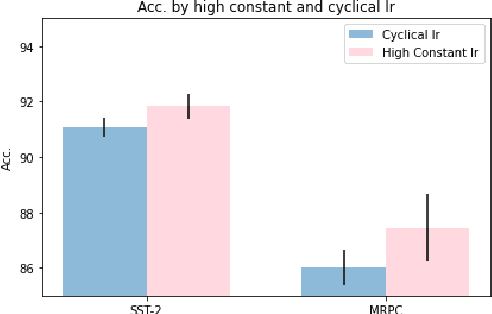
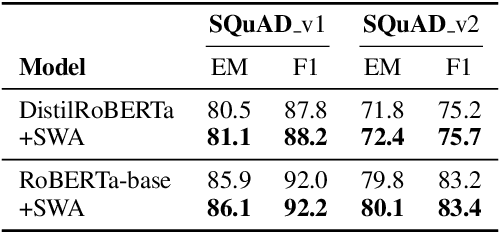
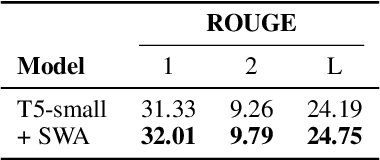
Abstract:Knowledge Distillation (KD) is a commonly used technique for improving the generalization of compact Pre-trained Language Models (PLMs) on downstream tasks. However, such methods impose the additional burden of training a separate teacher model for every new dataset. Alternatively, one may directly work on the improvement of the optimization procedure of the compact model toward better generalization. Recent works observe that the flatness of the local minimum correlates well with better generalization. In this work, we adapt Stochastic Weight Averaging (SWA), a method encouraging convergence to a flatter minimum, to fine-tuning PLMs. We conduct extensive experiments on various NLP tasks (text classification, question answering, and generation) and different model architectures and demonstrate that our adaptation improves the generalization without extra computation cost. Moreover, we observe that this simple optimization technique is able to outperform the state-of-the-art KD methods for compact models.
Learning Functions on Multiple Sets using Multi-Set Transformers
Jun 30, 2022



Abstract:We propose a general deep architecture for learning functions on multiple permutation-invariant sets. We also show how to generalize this architecture to sets of elements of any dimension by dimension equivariance. We demonstrate that our architecture is a universal approximator of these functions, and show superior results to existing methods on a variety of tasks including counting tasks, alignment tasks, distinguishability tasks and statistical distance measurements. This last task is quite important in Machine Learning. Although our approach is quite general, we demonstrate that it can generate approximate estimates of KL divergence and mutual information that are more accurate than previous techniques that are specifically designed to approximate those statistical distances.
Revisiting Pre-trained Language Models and their Evaluation for Arabic Natural Language Understanding
May 21, 2022
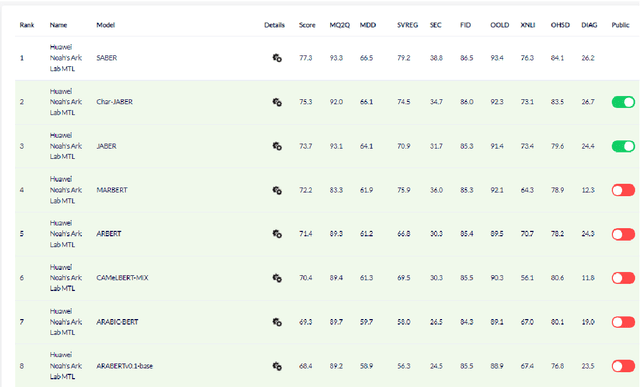

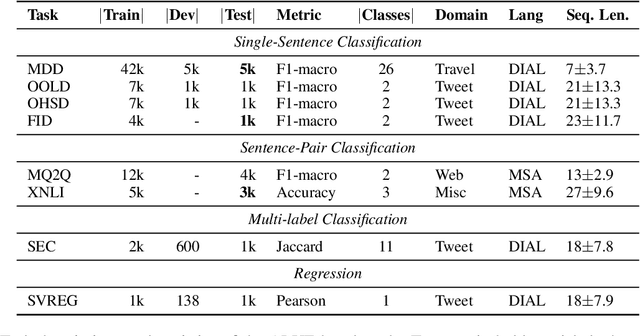
Abstract:There is a growing body of work in recent years to develop pre-trained language models (PLMs) for the Arabic language. This work concerns addressing two major problems in existing Arabic PLMs which constraint progress of the Arabic NLU and NLG fields.First, existing Arabic PLMs are not well-explored and their pre-trainig can be improved significantly using a more methodical approach. Second, there is a lack of systematic and reproducible evaluation of these models in the literature. In this work, we revisit both the pre-training and evaluation of Arabic PLMs. In terms of pre-training, we explore improving Arabic LMs from three perspectives: quality of the pre-training data, size of the model, and incorporating character-level information. As a result, we release three new Arabic BERT-style models ( JABER, Char-JABER, and SABER), and two T5-style models (AT5S and AT5B). In terms of evaluation, we conduct a comprehensive empirical study to systematically evaluate the performance of existing state-of-the-art models on ALUE that is a leaderboard-powered benchmark for Arabic NLU tasks, and on a subset of the ARGEN benchmark for Arabic NLG tasks. We show that our models significantly outperform existing Arabic PLMs and achieve a new state-of-the-art performance on discriminative and generative Arabic NLU and NLG tasks. Our models and source code to reproduce of results will be made available shortly.
JABER and SABER: Junior and Senior Arabic BERt
Jan 09, 2022
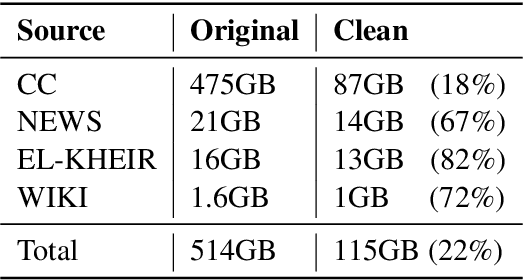
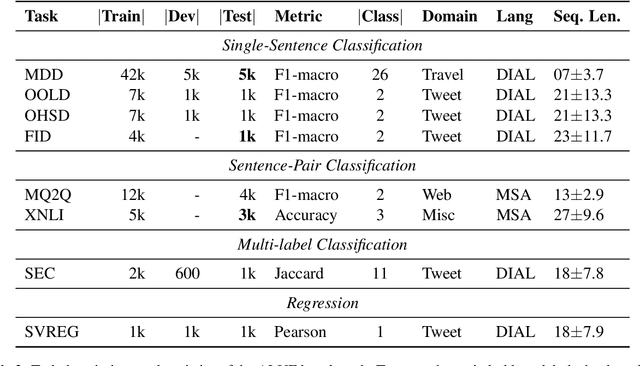
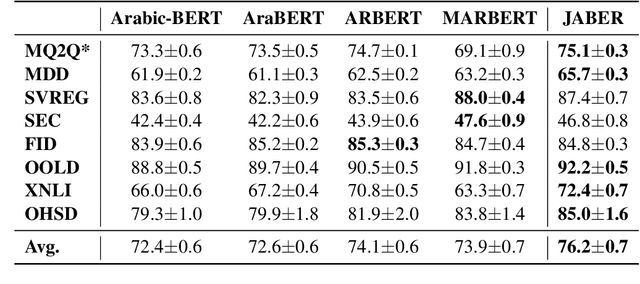
Abstract:Language-specific pre-trained models have proven to be more accurate than multilingual ones in a monolingual evaluation setting, Arabic is no exception. However, we found that previously released Arabic BERT models were significantly under-trained. In this technical report, we present JABER and SABER, Junior and Senior Arabic BERt respectively, our pre-trained language model prototypes dedicated for Arabic. We conduct an empirical study to systematically evaluate the performance of models across a diverse set of existing Arabic NLU tasks. Experimental results show that JABER and SABER achieve state-of-the-art performances on ALUE, a new benchmark for Arabic Language Understanding Evaluation, as well as on a well-established NER benchmark.
 Add to Chrome
Add to Chrome Add to Firefox
Add to Firefox Add to Edge
Add to Edge